 The birth of the Austrian Navy
The birth of the Austrian Navy
The history of the Austrian Navy can be traced back to 1382 when Trieste came under Austrian protection and in the 17th a small ragtag naval force was created there. During the 13th and 14th centuries, Trieste became the great maritime trade rival to the Republic of Venice, close neighbours of the Adriatic and they went at war between 1283 and 1372. After the Peace of Turin in 1381, Venice renounced its claim to Trieste and the latter citizens petitioned Leopold III, the Duke of Austria for protection. Therefore it became part of the Duchy of Austria, and a treaty was signed in the castle of Graz on 30 September 1382. This gave a port to Austria, a landlock Empire for the first time, and a large and prosperous one.
Austria knew this “golden eggs hen” needed to be ruled with a velvet glove and in fact, the city was given a large degree of autonomy. The Dukes of Austria in fact neglected the idea of having a fleet to protect it. This was left to the City itself.

Austrian Frigates by Ludwig Rubelli Von Sturmfest
Articles
 Ship of the Line SMS Kaiser
Ship of the Line SMS Kaiser
 Radetzky class Frigates
Radetzky class Frigates
 Erzherzog Friedrich class Corvettes
Erzherzog Friedrich class Corvettes
 Novara class Frigates
Novara class Frigates
(More to come)
The 17th Century
The situation remained unchanged until the late 18th century. At last there was a first attempt of a proper Austrian navy, as during the Thirty Years War, Generalissimo Albrecht von Wallenstein (Duke of Mecklenburg) also became “Admiral of the North and Baltic Seas” by the Holy Roman Emperor Ferdinand II in 1628. Wallenstein’s attention was in the baltic and he was eventually assassinated in 1634, precisely to prevent an Austrian navy to be active in the North or Baltic Seas.
Austria however later built a presence on the mighty Danube River, “the european mississippi”, and dring the Great Turkish War, Prince Eugene of Savoy deployed a small flotilla on this natural border with the Ottoman Empire, something the House of Habsburg did on occasion in the 16th and 17th centuries. These river flotillas mostly transported troops across the Danube and controlled the river.
The 18th Century
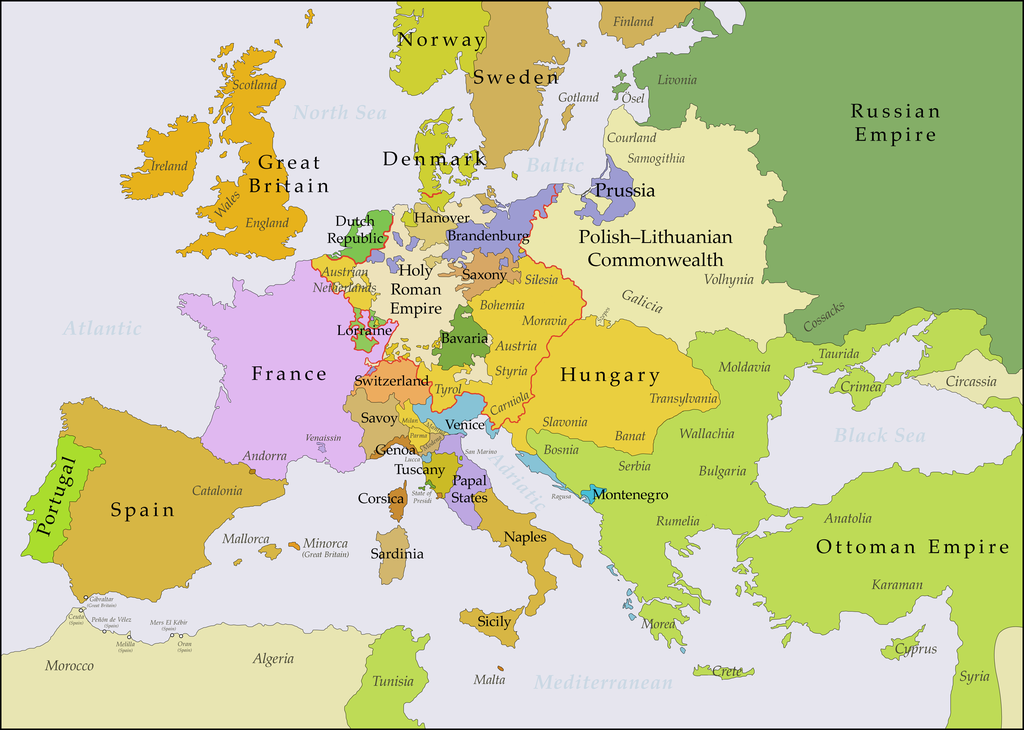
Map of Europe 1870
This would take time for Austria to develop a seagoing navy: The French Navy shelled the port of Trieste during the War of Spanish Succession, devastating port installations for a decade. Austria was aware of its inability to defend its coast in the Adriatic and when was signed the treaties of Utrecht, Rastatt, and Baden, Austria gained the Spanish Netherlands, Kingdom of Naples, Sicily, Sardinia, and Duchy of Milan (Sardinia and Naples were lost to Spain in 1734) but these territories gave a huge coastal and maritime possession, Austria was still unable to defend, but “leasing” the local fleets and gave them full autonomy.
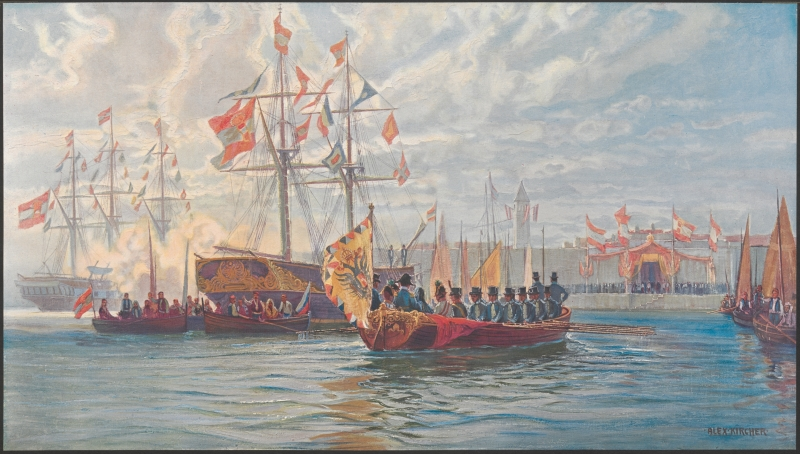
Arrival of Emperor Franz Joseph I in Zara, 1818
The War of Spanish Succession saw Austria trying again to develop a navy, also mirroring the growing Europan interest in mercantilism, colonial Empire and merchant fleets, chartering of overseas trading companies. Austria was still marred in its ambitions by geography, despite having a long coastline in the eastern Adriatic its major ports were isolated from Vienna by the Austrian Alps with no major rivers to make the link. Despite of thios, Austria used the Elbe, Oder, and Danube whenever possible for internal traffic, but the coastal roads went through mountains populated by brigands, a perilous proposition. The Elbe and Oder also flowed through Prussia and into the North and Baltic Seas, and can be blockaded, while the mouth of the Danube was part of the Ottoman Empire, both major rivals for Austria.
The Ostend Company
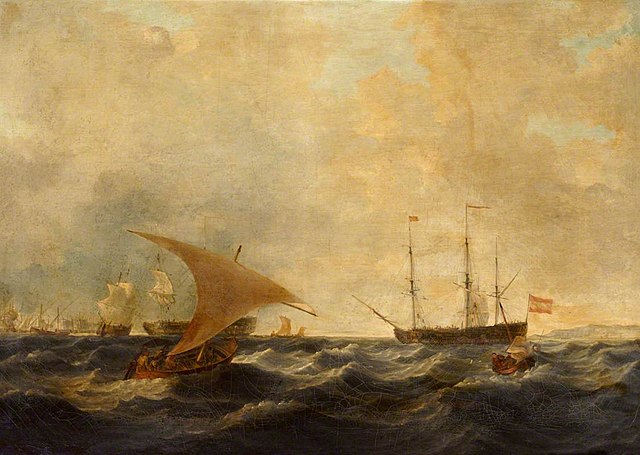
Following the War of Spanish Succession, Austria’s only main access to the sea was its newly acquired Austrian Netherlands. Laying within the boundaries of the Habsburg Holy Roman Empire, the provinced had numerous ports with easy access to the Atlantic and skilled sailors and ships construtors. Ghent, Antwerp, Bruges and Ostend in particular, but there was a disconnection between the Austrian economy and in the Netherlands, as the province was mostly left alone. Prince Eugene of Savoy from June 1716 even never travelled there, preferring to stay in Vienna, sending chosen representatives instead.
Dutch, British and French East India Companies until the 18th centuries developed themselves rapidly, and when merchants and shipowners in Ostend started to create trade to the East Indies, this attracted the attention of the Austrian court. In December 1722, Charles VI granted a 30-year charter to the Ostend Company, trading both with the East and West Indies, and down south to Africa. The Ostend Company became extremely profitable operating until 1732 no less than 21 Indiamans, with prized destinations such as Canton. Soon rising tea prices alone broughts massive profits and until 1728, the Ostend Company carried some 7 million pounds of tea, almost half of the total in Europe back then, rivalling with the East India Company. The Ostend Company however was suspended by Charles VI due to British diplomatic requests manoeuvers after the Treaty of Vienna. All operations ceased in 1731.
Austrian East India Company
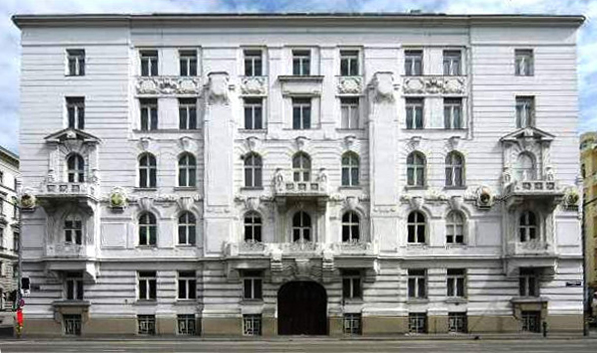
Marine sektion in Vienna
Holy Roman Emperor Charles VI saw the success of the Ostend Company and started to create a proper navy to ensure its protection. One of these initiative was also a land road through the Semmering Pass from Vienna to Trieste. Trieste and Fiume weere also declared free ports to boost their activity in 1719. Piracy in the Adriatic and Mediterranean was a thing, so the King soon purchased a single three-decker, the British-built 80-gun, 3rd rate man-o-war Cumberland, in 1720. She became SMS San Carlos, and was stationed in Naples. Construction of more ships started, employing Italian and Spanish officers to crew them. This early Adriatic fleet comprised three ships of the line, a single frigate and several galleys, with perhaps 500 guns between them and 8,000 men. After the end of the Ostend Company however, a committee was created in 1738 by Emperial decree, making a review of the Austria’s Adriatic fleet.
The report concluded the fleet had little utility while being expensive while still vulnerable. Charles VI then decided to cancel the Adriatic fleet, transferring most guns and crews to the more urgent Danube Flotilla.
Charles VI passed out on 19 October 1740 and Frederick II of Prussia invaded Austria in December, taking Silesia in the War of the Austrian Succession (seven-year war). Austria’s fought entirely on land, its Danube fleet being comitted. Maria Theresa however dimissed the navy entirely and focused on the inheritance of the throne of Austria. Meanwhile, pirates and privateers, Barbary corsairs hampered Austria’s trade, left wthout protection, to such point that supplies were now carried by foreign ships. Count Kaunitz decided by himesf and without support to create a small force of frigates for the Adriatic, Vienna being still indifferent. His initiative fell through.
In 1775, there was another attmpt to create a maritime trading venture, the Austrian East India Company, headed by William Bolts. The first trip started to India began on 24 September 1776, with the Indiaman Giuseppe e Teresa, sailing from Livorno (Grand Duchy of Tuscany, ruled by Maria Theresa’s son Leopold). After this first success, Bolt obtain a 10-year charter, opening roads to Persia, India, China and Africa.
The Austrian East India Company developed for the next two years, with factories and depots on the Malabar Coast, but also southeastern Africa (Delagoa Bay) and the Nicobar Islands. However th campany failed to be profitable pressured by well-established, aggressive colonial powers, such as Portugal and the Kingdom of Denmark-Norway. Bolts was evicted from Africa and the Bay of Bengal and the Austrian government caved in to avoid another war. For the next 20 years Vienna did not tried to resurrect the company or a navy to protect it. Until the late 1700s, the Austrian government still hoped Trieste and Fiume would create this fleet, which never happened.
The first true Austrian Navy (1786)
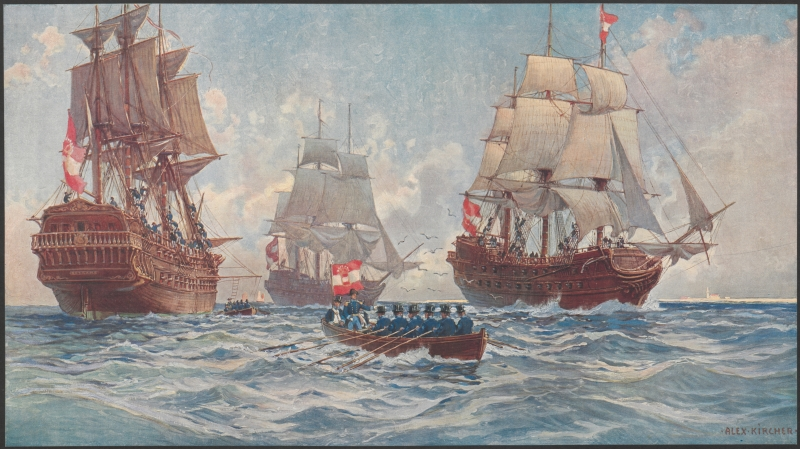
Laharpe, Beyrand and Stengel, taken in Ancona, 1799
The Austrian Navy was at last create, established for good, in 1786. Emperor Joseph II ordered two 20-guns cutters in Ostend to be based Trieste. A perfect ship to deal with piracy. Joseph II created also the first Austrian Navy Naval Ensign, maintained until 1915: Red-white-red and showing the crown of the Archduchy of Austria. It replaced the traditional yellow and black flag inherited from the Habsburg Monarchy. As the French Revolution was about to start in 1789, followed by Revolutionary Wars. It saw the largest expansion of the Austrian Navy under the young Leopold II. Back then, the Austrian Navy was based in and off Trieste. In 1797 the Treaty of Campo Formio ended the War of the First Coalition and Austria ceded to France the Netherlands and islands such as Corfu and some islands in the Adriatic belonging to Venice. The Republic of Venice saw its territories divided, Austria receiving Venice, Istria and Dalmatia. Its naval forces became the bedrock of the new Austrian Navy, as well facilities and crews, the base for the future Austrian Navy.
Campo Formio saw ustria becoming overnight the dominant naval power in the Adriatic. However Venice suffered under French occupation and ships acquired amounted to 37 vessels in 1799, mostly small coastal craft (111 guns, 787 crew). This small force, in poor condition was unable to project power, and could only patrol and protect Austrian shipping in the Adriatic. Ancona was acquired in 1799, and the navy gained three former Venetian ships of the line: Laharpe, Stengel and Beyrand. These were 74 guns vessels, but the Austrian government chose to sell them instead; New regulations were imposed notably the instructon of officers and captains regarding discipline, speaking German, and business transactions or surgeons to fumigate their ships. Gradually the Austrian navy made a transition from Spanish and Italian crews towards Germanic officers in 1848, in part to better integrated its multi-ethnic Empire.
The XIXth Century
From 1817 to 1848
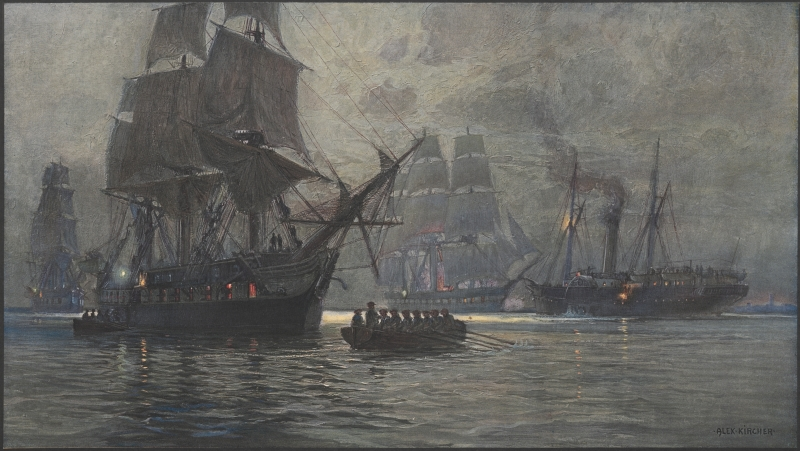
Blockade of Venice 1830
By the end of the 1700s the Austrian Navy started to be rebuilt after the Congress of Vienna. Political necessities were the engines behind as well as more favourable economic conditions: For example in 1817 the marriage between the Archduchess Maria Leopoldina and Emperor Pedro I of Brazil saw the first overseas trip by the Austrian Navy with the Archduchess onboard SMS Augusta and Austria. They dropped anchor in Rio de Janeiro. In 1820, the frigate SMS Carolina escorted the ships making the trip back with the Brazilian Emperor. Later the same frigate sailed to China. In the early 1830s Austrian trade along the Danube and in the Mediterranean rode quickly in scale and in 1830, the Austrian Danube Steam Navigation Company was created. In 1834 the Mediterranean was now crossed regularly be the steamship Marie Dorothee, making her first trip between Trieste and Constantinople. In 1836, the Austrian Lloyd, first national insurance maritime company, was established. The merchant marine needed a strong Austrian Navy to provide protection on the high seas, and grew alongside.
The Greek War of Independence was the occasion for the Austrian Navy to engage Greek pirates. They indeed more often preyed on Austrian shipping. Not by politocal needs but to fund the Greek rebellion against Ottoman rule. Barbary corsairs did the same in the Western Mediterranean. Austria’s naval forces were soon hard-pressed and stretched thin. In 1829, two Austrian corvettes, a brig, and a schooner (Lt.Cdr Franz Bandiera) threatened Morocco to obtain the release of a captured Austrian merchant ship, which they refused to do so, leading to the bombardment of Larache. This action was sufficient to end of North African pirates actions against Austria.
The 1830s modernization was the occasion for the construction of additional ships, purchasing guns and other equipments as well. For the first time, steamships were to be integrated, notably as dispatch vessels as customary at the time. The first was the 500-tonne paddle steamer SMS Maria Anna (Fiume Shipyard), commissioned in 1836. Archduke Friedrich Leopold also joined the Navy and boosted its morale and prestige, being instrumental in modernizing its ships and institutions, bases and arsenals. It was by then that the “Venetian” nature of the Austrian Navy started to change drastically. The first serious test of this “new navy” came with the Oriental crisis of 1840.
The First Egyptian-Ottoman War had Muhammad Ali of Egypt conquering Syria, reclaimed in 1839 by the Ottomans, later defeated at the Battle of Nezib. Soon the Convention of London was signed, in which the United Kingdom, Austria, Prussia, and Russia sent a force to support the Ottoman Empire, offering Muhammad Ali hereditary rule in Egypt in exchange to staying in the Ottoman Empire and withdrawing from Syria. Since he never agreed, a multinational force was sent in September 1840 and the British and Austrian navies blockaded the Nile Delta, shelling Beirut. The Frigate Guerriera shelled Sidon and both nations later landed a party which stormed its coastal fortifications. Sidon fell on 28 September. Next, the Austrian shelled Acre in November, getting rid of its coastal fortifications and later storming the city. Friedrich Leopold ditinguidhes himself at this occasion, personally leading the landing party, hoisting flage don the citadel and later awarded the Knight of the Military Order of Maria Theresa. In 1844 her became Vice-Admiral and later Commander-in-Chief of the Navy, still aged 23, but he died in Venice three years later.
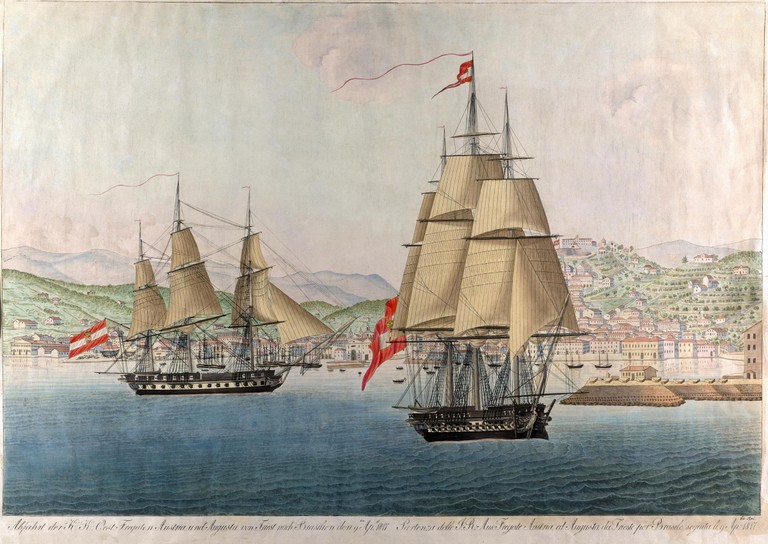
Giovanni Pass – Austrian Frigates in 1817
The events of 1848, the “spring of revolution” across Europe saw a rapid rise in nationalism, Venice became independent, and the only three Austrian corvettes and a few vessels fell in the hands of rebels, as well as the arsenal and stores. Together with it, the “Italian” character of this early navy disappeared with it. Instead, various nationalities within the empire would be represented, as well as North European and more Germanic traditions, and in 1849, some Italian Republics declared war on Austria but were defeated.
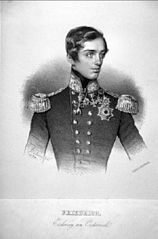 Eventually Austria retook Venice and the fleet that was there and the previous year as Franz Joseph I became Emperor of Austria, he appointed a Dane, Rea Admiral Hans Birch Von Dalherup as Commander in Chief of the Navy to develop and modernize it. From there, all ships listed would be added the prefix “SMS” for “Seiner Majestät Schiff” but after two years in office, Von Delherup resigned. In 1850, Archduke Ferdinand Max, brother of the Emperor was appointed C-in-C in is place. He started to develop a more ambitious force, far from the coastal hotchpoth of mixed vessels dominated by corvettes and gunboats. There was also an old sailing fleet made from antiquated vessels, most of them being French:
Eventually Austria retook Venice and the fleet that was there and the previous year as Franz Joseph I became Emperor of Austria, he appointed a Dane, Rea Admiral Hans Birch Von Dalherup as Commander in Chief of the Navy to develop and modernize it. From there, all ships listed would be added the prefix “SMS” for “Seiner Majestät Schiff” but after two years in office, Von Delherup resigned. In 1850, Archduke Ferdinand Max, brother of the Emperor was appointed C-in-C in is place. He started to develop a more ambitious force, far from the coastal hotchpoth of mixed vessels dominated by corvettes and gunboats. There was also an old sailing fleet made from antiquated vessels, most of them being French:
From 1848 to 1860
After a the success of the revolution in France in February, revolutionary fervor across Europe had repercussions, including in Vienna: Austrian Chancellor Klemens von Metternich resigned, left in exile to London and Emperor Ferdinand I abdicated in favor to his nephew Franz Joseph, promising reforms. Nationalist sentiments across the Empire, bwteen ethnic groups led to the several revolutions in Austria, but with prevalent Liberal sentiments among Austrians, but the Hungarians soon wanted to establish their own independent kingdom, and Italians within the the Austrian Empire stated to remigrate to Italy. Vienna own Revolution triggerred anti-Habsburg riots in Milan and Venice, but Field Marshal Joseph Radetzky could not beat the coalized Venetian and Milanese insurgents on the Lombardy-Venetian front, in fact, avacuating western Italy altogether. He setup a line of defensive fortresses between Milan and Venice (‘Quadrilatero’). Eventually on 23 March 1848, The Kingdom of Sardinia declared war on Austria, starting the First Italian War of Independence.
The “old fleet”
 74-guns frigates:
74-guns frigates:
Three ships of the Temeraire class, mass-produced (107 built) Napoleonic 74-cannons, 1st rank frigates which saw little service in the Austrian Navy, SMS Carolina (1808) Ex-French Carolina, Bellona (1811) – ex-French Régénérateur and Reale Italiano (1812) – ex-French Royal Italien. Likely part of the Italian Napoleonic Navy, built in Venice and captured by Austria, but discarded in 1830 and 1838 respectively.

Lipsia class:
Due to the revived ties of Napoleon with Austria, an entire class of ships built from 1811, called in France the Pallas class, 40-guns frigates, among which a few were part of the Napoleonic Italian Fleet later donated to Austria: The SMS Lipsia (1811)- ex Princesse de Bologne, SMS Austria (1812) – ex-French Piave, SMS Augusta (1813) – ex-French Amphitrite, SMS Ebe (1820) – ex-French Hébé, SMS Medea (1827) – ex-French Moskva, SMS Juno (1829) – ex-French Guerrière and SMS Venere (1832) – ex-French Vénus. The French built no less than 57 of these, all designed by Sané. Most of those listed were attributed to Austria when completed, so they never saw service with France. Their status is difficult to pinpoint in 1860. Some clearly were still around, used as pontoon or barges, or for training. Corona, built in Venice and started in August 1812 saw her Construction abandoned April 1814 at the fall of Venice to the Austrians. The same fate awaited Istrienne in 1813.
 Sailing Corvettes:
Sailing Corvettes:
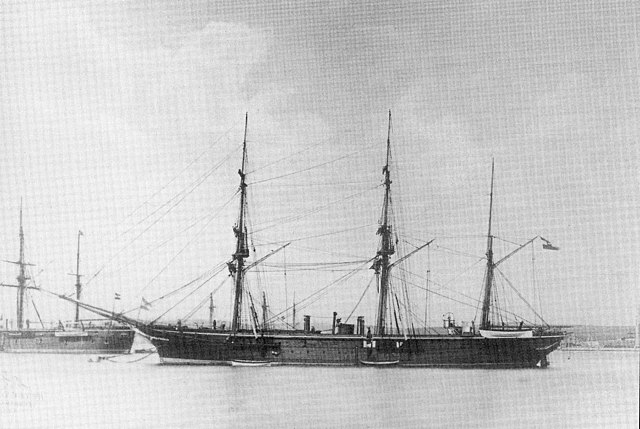
SMS Zrinyi in 1878
SMS Diana (1834), SMS Minerva (1838), SMS Carolina (1844)
 Sailing Brigs:
Sailing Brigs:
SMS Montecuccoli (1831), SMS Pola (1832), SMS Pylades (1843), SMS Hussar (1847)
 Schooners (goelettes)
Schooners (goelettes)
SMS Camaeleon (1833), SMS Fido (1834), SMS Bravo (1837), SMS Dromedar (1837), SMS Arethusa (1850), SMS Arthemisia (1851), SMS Saida (1855)
 Paddle steamers (Radaviso)
Paddle steamers (Radaviso)
SMS Vulcano (1843), Messagiere (1847), Achilles (1848), Custoza (1848), Curtatone (1848), Roma (1848), Santa Lucia (1850), Volta (1850), Kaiserin Elisabeth (1850), Taurus (1851), Gorzkowski (1854), Prinz Eugen (1854), Jupiter (1857)
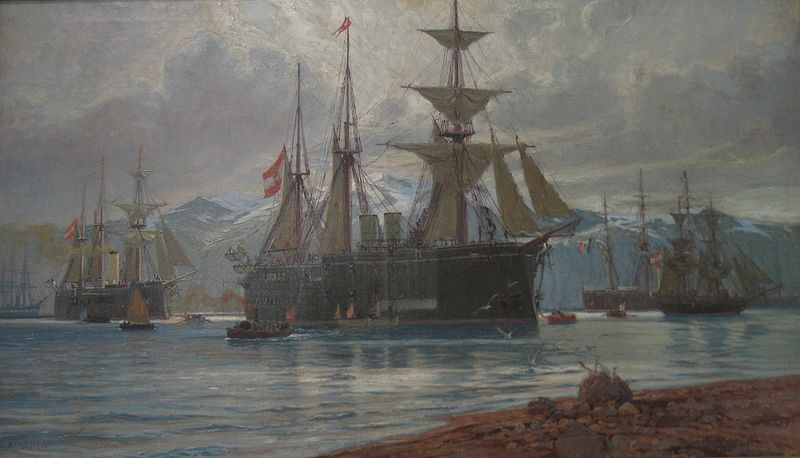
The “new fleet” in the 1870s, painting from HGM Kirchner
The Austrian Navy in 1860
Note this was the Austrian Navy, not Austro-Hungarian Navy yet. The Empire was unified after 1867 as a consequence of the Italian Independence and nationalists action. The flag was the classic three bands red and white with Royal armories.
Ships of the line
 Kaiser (1858)
Kaiser (1858)
SMS Kaiser was a 92-gun wooden ship of the line, the last vessel of the type when built, and only screw propelled ship of the line built by the Austrians, at the shipyard of Pola. Laid down in March 1855, launched in October 1858, completed in 1859 she soon took part in the Second Schleswig War of 1864 in the North Sea. She also took part in the “Seven Weeks War” in 1866,and famously the monumental Battle of Lissa as flagship, with Admiral Anton von Petz leading the Austrian 2nd Division. Despite her old style, she engaged several Italian ironclads at once and even rammed Re di Portogallo, while aldo badly damaging by gunfire Affondatore.
These duels between old school ships of the line and ironclads remained the only ones in history. Quickspecs: 5,811t, 2-24 pdr ML rifles, 16-40 pdr SB, 74-30 pdr SB, 11.5kts
In 1869, Kaiser was taken in hands to be rebuilt into a casemate ironclad, until 1873 but delayed because of budgetary issues. Armor plate notably came from British companies and casemate ships were in 1873 already superseded by turret ships. So Kaiser, barely completed, served only until 1875 (So three years) actvely, before place din reserve until 1902 in reserve with additional upgrades and modernizations in the 1880s. From 1901 she became SMS Bellona, disarmed and converted as a pontoon, barracks ship in Pola until WWI. Seized as a war prize by the Italians she was likely scrapped not long after.
Drache class Ironclads – Started Feb. 1861:
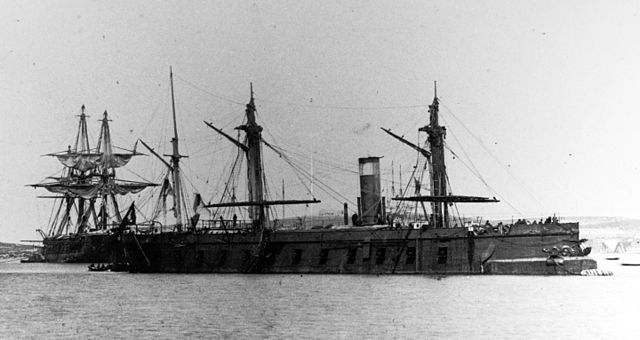
The first Austrian Ironclads, studied from 1860 by Joseph Von Romako, as quick adaptation of 3rd class frigates. They Laid down in February, launched in 9 September 1861, completed in November 1862 so after the end of this topic, but the Drache and Salamander marked a turning point fior the Austro-Hungarian Navy which had a first, and quite severe test in 1866. Indeed, they were built at Trieste, in response to the Italian Formidabile, which itself responded to the French Gloire of 1859. Barely five years after the Crimean war where it was obvious that fleets needed to upgrade their sailship to steam whatever their size and drank, the concept of ironclad stepped in and a new race, typical of this industrial era, was on. See more in the 1870 page (in writing).
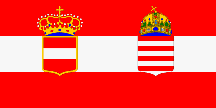
Modern Screw frigates
 Radetzky class (1854)
Radetzky class (1854)
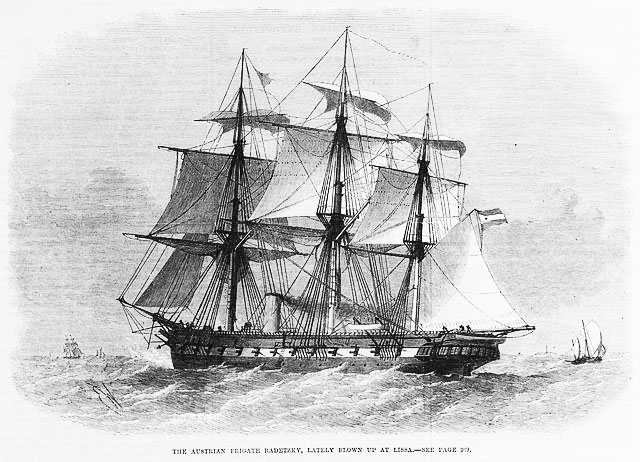
SMS Radetzky was the largest screw frigate in the Austrian Navy. She was built by Money, Wigram & Sons of London, named after field marshal Joseph Radetzky von Radetz. Launched in 1854, she participated in the Battle of Heligoland with the Prussians and against the Danes, during the Second Schleswig War of 1864. Although this is off-topic qhe would be also made famous by her epic fight at the Battle of Lissa during the Austro-Prussian War in 1866. In 1869 her powder magazine exploded for obscure reasons, off the coast of Vis (Adriatic). She sank with almost all her crew, 345 men and officers out of 369. Her wreck was rediscovered in 2014 and a memorial service was held.
Adria (1856)
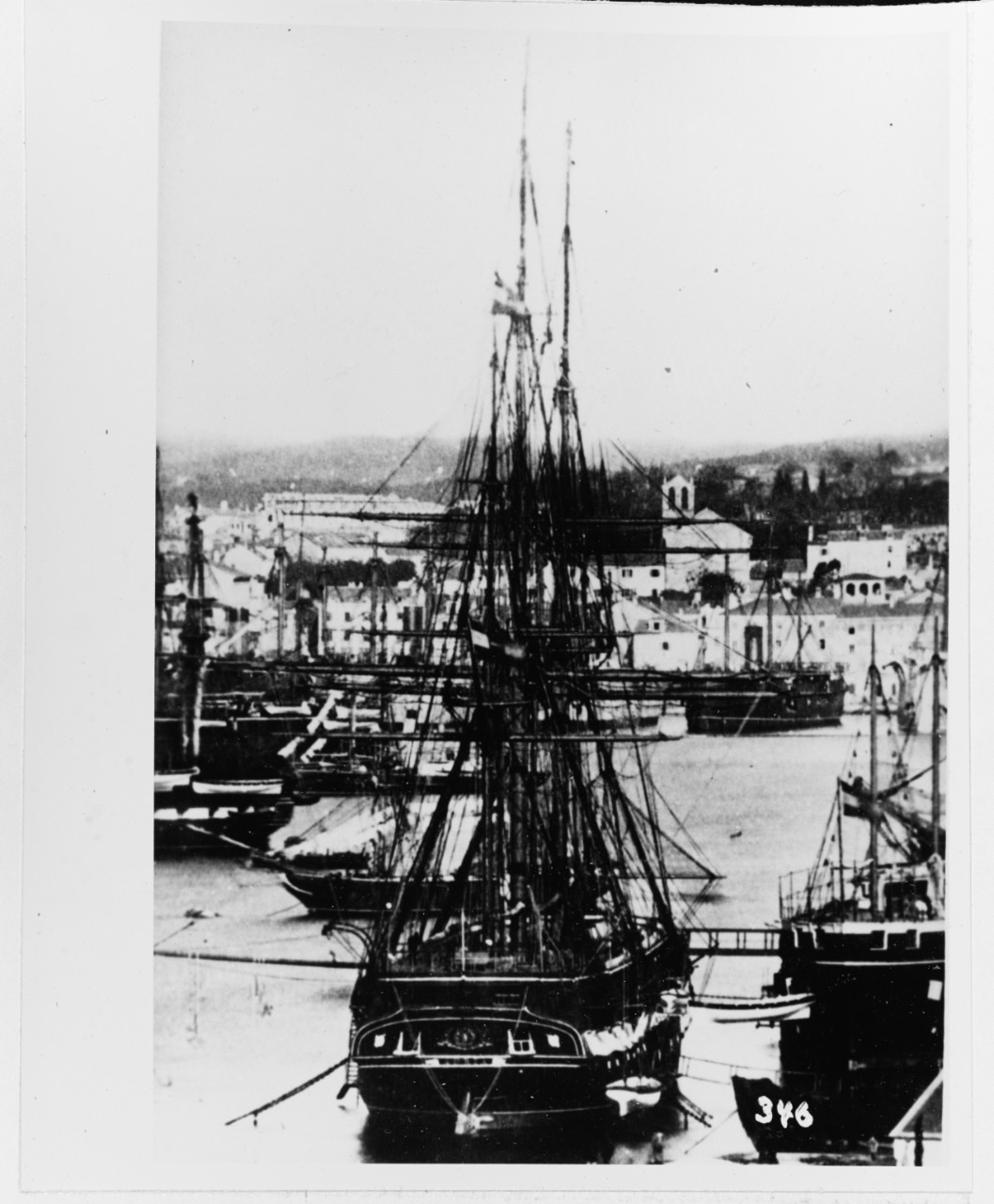
SMS Adria was a 1st rank Frigate, noted on Conway’s as a 50 guns, very similar to Radetzky.
Donau (1856): 50 guns Frigate and rear-sister ship of Radetsky and Adria, she was launched the same year as Adria.
 Novara (1850) – Sailing frigate, converted 1862
Novara (1850) – Sailing frigate, converted 1862
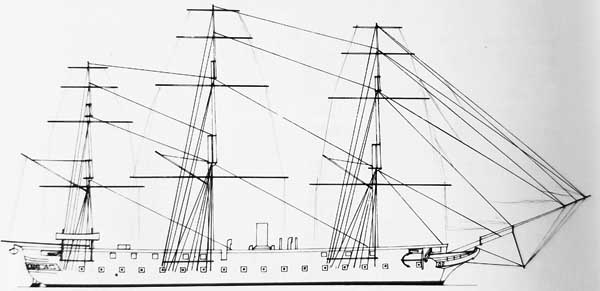
Also close to the ships above, Novara was also arguably the best known for historical reasons. She only was converted in 1862-65. SMS Novara is also the oldest entry in Conways, and as stated, was laid down as the Frigate Minerva in 1843, launched 1850 and completed in 1851. In 1868 she was rearmed with thirteen 24-pdr Wahrendorf BL, thirty two 30 pdr ML, two 4-pdr ML, and in 1872 she was given twenty 24 pdr BL, ten 24 pdr in the battery dekc, on the main deck, two 24 BL on pivot, and two 3-pdr landing guns. Names after the battle of Novara (1849), she was mostly made famous however for her expedition of 1857-59, the first large scale scientific expedition led by Austria. Sponsored by Ferdinand Maximillian and the great German scientist Alexander von Humboldt she made an extended voyage of discovery to the Far East and the Pacific. She is placed on the same level as the HMS Challenger, Endeavour, Beagle and Astrolabe or USS Peacock to name but a few. She also took part in the battle of lissa and stayed in service until 1876, became an utility hulk, a stationary gunnery TS in 1881, stricken on 1898 and scrapped a year later. She was by then 56 years old.
 Schwarzenberg (1853) – Ex-sailing frigate, 1862
Schwarzenberg (1853) – Ex-sailing frigate, 1862
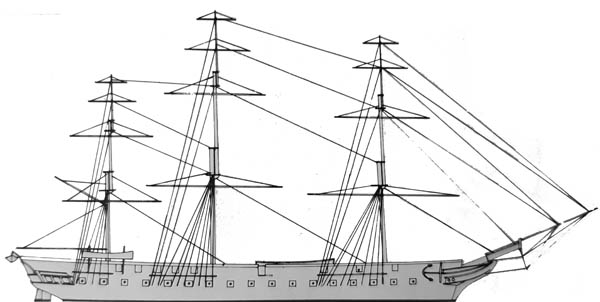
Very similar to Novara and like Novara built in Venice, she was also converted in 1861-62 with the same type of engine. She was shorted, beamier with the higher draft but same official displacement. She also had a heavier armament, changed in 1866 after Heligoland to just four 30 pdr removed.
Modern Screw corvettes
 SMS Erzherzog Friedrich class Corvettes (1857)
SMS Erzherzog Friedrich class Corvettes (1857)
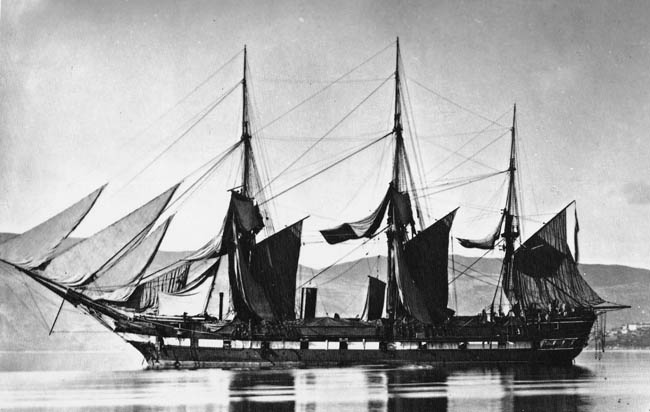
Composite Frigate, at the origin built as a sailing one, but converted on the stock to steam. generally similar to Novara (same machinery, tonnage and armament) after her conversion in 1861-62 her engine as pore powerful, yet she was slower at 11 knots versus 12 on Novara. She took part in the 1864 war against Denmark at Heligoland and in 1870-90 served as cadet training ship. She was stricken on 20 November 1890.
Quick specs: 76.79 x 14.32 m x 5.8 m, 2,615 t (2,574 long tons), Crew 550, Propulsion (1865*), one shaft CP 4 Boilers 12 kts 3,300 nm range, armament 4 × 60-pdr Paixhans, 28 × 30-pdr, 2 × 24-pdr BL
Regia marina at Ancona after the battle, basically Lissa was mostly a draw. Both the young composite Kingdom and the immense south-eastern Empire stayed defiant across the adriatic for more decades, and until 1919. Both Navies grew stronger by competing all along.
Read More/Src
Conway’s all the world”s fighting ships 1860-1905
Alain Demerliac, Nomenclature des navires francais de 1800–1815
Rif Winfield & Stephen S Roberts, French Warships in the Age of Sail 1786-1861: Design, Construction, Careers and Fates. Seaforth Publishing 2015
List
Austria
austro-hungarian navy (global)
Nava ensigns
(DE) Karl Gogg, Österreichs Kriegsmarine 1848-1918, Salzburg, Verlag das Bergland-Buch, 1974
Cesare Augusto Levi, Navi da guerra costruite nell’Arsenale di Venezia dal 1664 al 1896, Venezia
Lawrence Sondhaus, The Naval Policy of Austria-Hungary, 1867-1918: Navalism, Industrial Development and the Politics of Dualism, West Lafayette, Purdue Univertity
Johannes Ziegler, Die Operationen der österreichischen Mawährend des Krieges 1866, Wien, J.B. Wallishauffer, 1866.

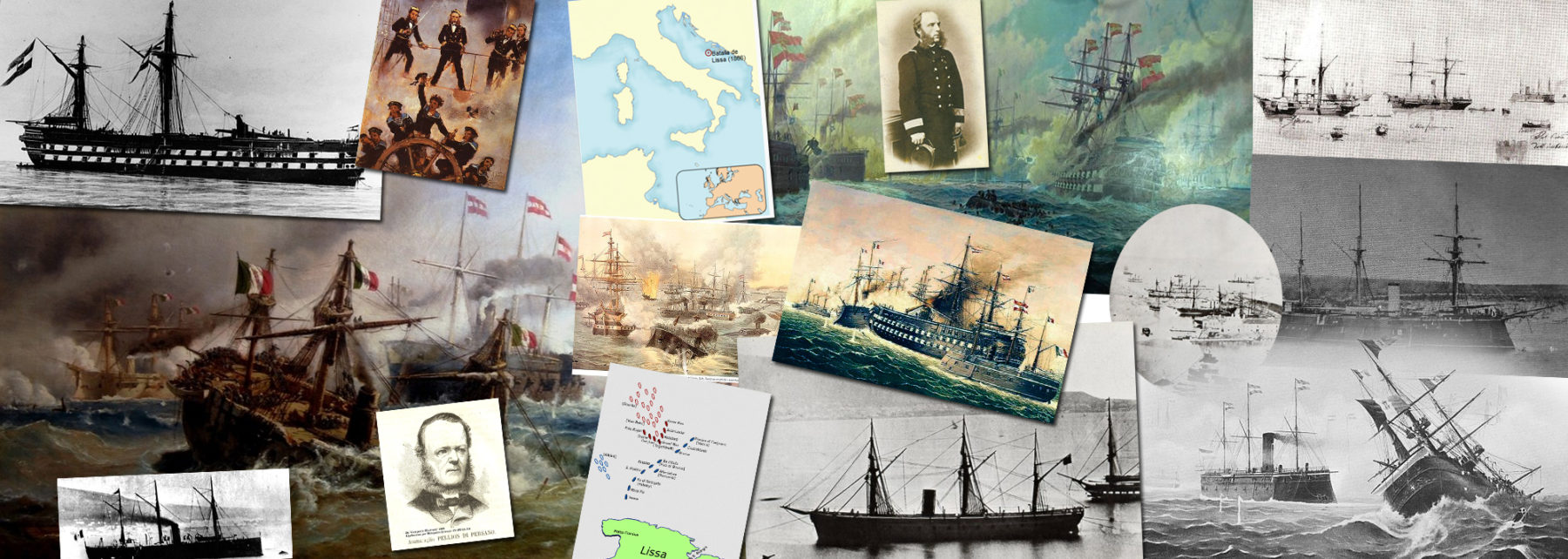
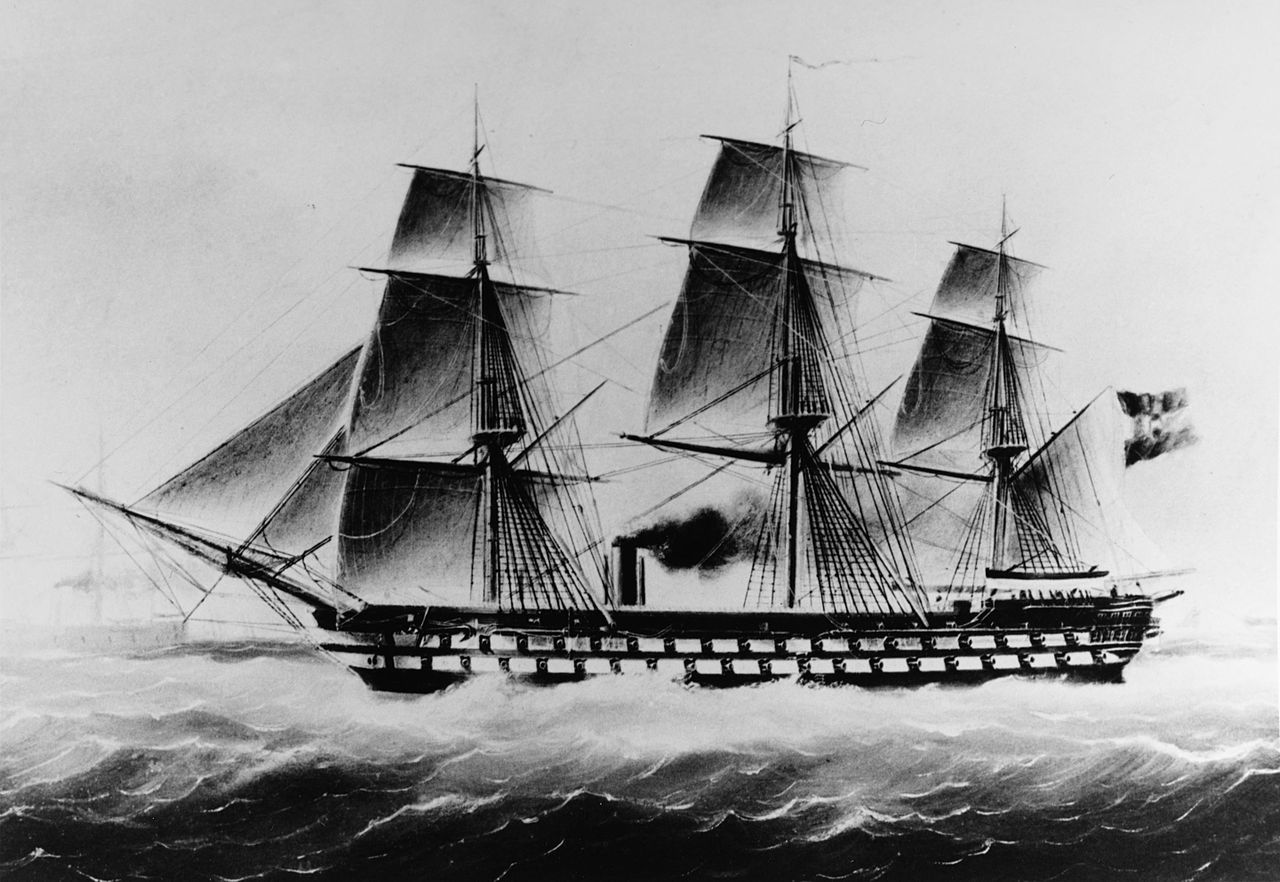
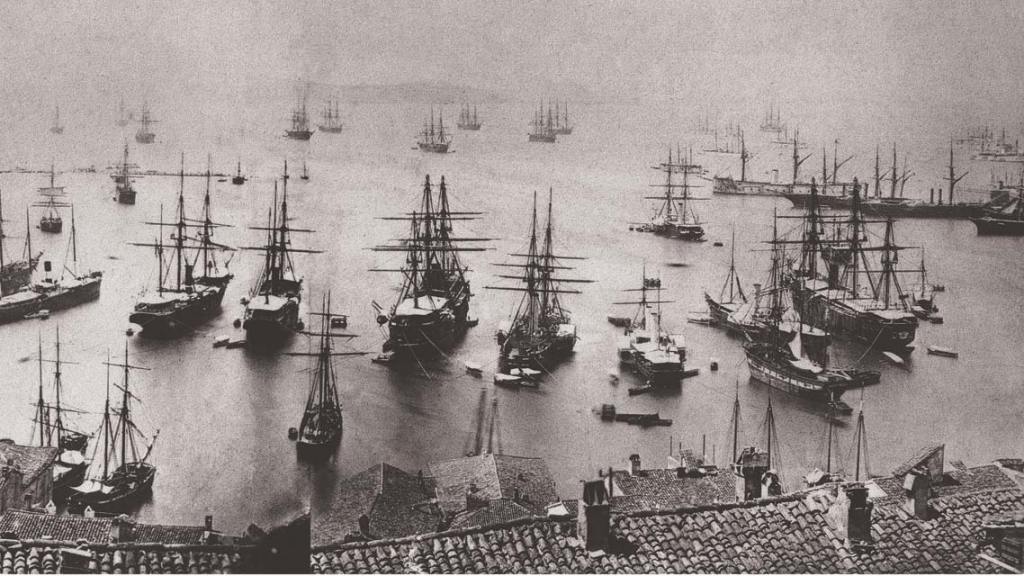
 Latest Facebook Entry -
Latest Facebook Entry -  X(Tweeter) Naval Encyclopedia's deck archive
X(Tweeter) Naval Encyclopedia's deck archive Instagram (@navalencyc)
Instagram (@navalencyc)





 French Navy
French Navy Royal Navy
Royal Navy Russian Navy
Russian Navy Armada Espanola
Armada Espanola Austrian Navy
Austrian Navy K.u.K. Kriegsmarine
K.u.K. Kriegsmarine Dansk Marine
Dansk Marine Nautiko Hellenon
Nautiko Hellenon Koninklije Marine 1870
Koninklije Marine 1870 Marinha do Brasil
Marinha do Brasil Osmanlı Donanması
Osmanlı Donanması Marina Do Peru
Marina Do Peru Marinha do Portugal
Marinha do Portugal Regia Marina 1870
Regia Marina 1870 Nihhon Kaigun 1870
Nihhon Kaigun 1870 Preußische Marine 1870
Preußische Marine 1870 Russkiy Flot 1870
Russkiy Flot 1870 Svenska marinen
Svenska marinen Søværnet
Søværnet Union Navy
Union Navy Confederate Navy
Confederate Navy Armada de Argentina
Armada de Argentina Imperial Chinese Navy
Imperial Chinese Navy Marinha do Portugal
Marinha do Portugal Mexico
Mexico Kaiserliche Marine
Kaiserliche Marine 1898 US Navy
1898 US Navy Sovietskiy Flot
Sovietskiy Flot Royal Canadian Navy
Royal Canadian Navy Royal Australian Navy
Royal Australian Navy RNZN Fleet
RNZN Fleet Chinese Navy 1937
Chinese Navy 1937 Kriegsmarine
Kriegsmarine Chilean Navy
Chilean Navy Danish Navy
Danish Navy Finnish Navy
Finnish Navy Hellenic Navy
Hellenic Navy Polish Navy
Polish Navy Romanian Navy
Romanian Navy Turkish Navy
Turkish Navy Royal Yugoslav Navy
Royal Yugoslav Navy Royal Thai Navy
Royal Thai Navy Minor Navies
Minor Navies Albania
Albania Austria
Austria Belgium
Belgium Columbia
Columbia Costa Rica
Costa Rica Cuba
Cuba Czechoslovakia
Czechoslovakia Dominican Republic
Dominican Republic Haiti
Haiti Hungary
Hungary Honduras
Honduras Estonia
Estonia Iceland
Iceland Eire
Eire Equador
Equador Iran
Iran Iraq
Iraq Latvia
Latvia Liberia
Liberia Lithuania
Lithuania Mandchukuo
Mandchukuo Morocco
Morocco Nicaragua
Nicaragua Persia
Persia San Salvador
San Salvador Sarawak
Sarawak Uruguay
Uruguay Venezuela
Venezuela Zanzibar
Zanzibar Warsaw Pact Navies
Warsaw Pact Navies Bulgaria
Bulgaria Hungary
Hungary

 Bundesmarine
Bundesmarine Dutch Navy
Dutch Navy Hellenic Navy
Hellenic Navy Marina Militare
Marina Militare Yugoslav Navy
Yugoslav Navy Chinese Navy
Chinese Navy Indian Navy
Indian Navy Indonesian Navy
Indonesian Navy JMSDF
JMSDF North Korean Navy
North Korean Navy Pakistani Navy
Pakistani Navy Philippines Navy
Philippines Navy ROKN
ROKN Rep. of Singapore Navy
Rep. of Singapore Navy Taiwanese Navy
Taiwanese Navy IDF Navy
IDF Navy Saudi Navy
Saudi Navy Royal New Zealand Navy
Royal New Zealand Navy Egyptian Navy
Egyptian Navy South African Navy
South African Navy






























 Ukrainian Navy
Ukrainian Navy dbodesign
dbodesign